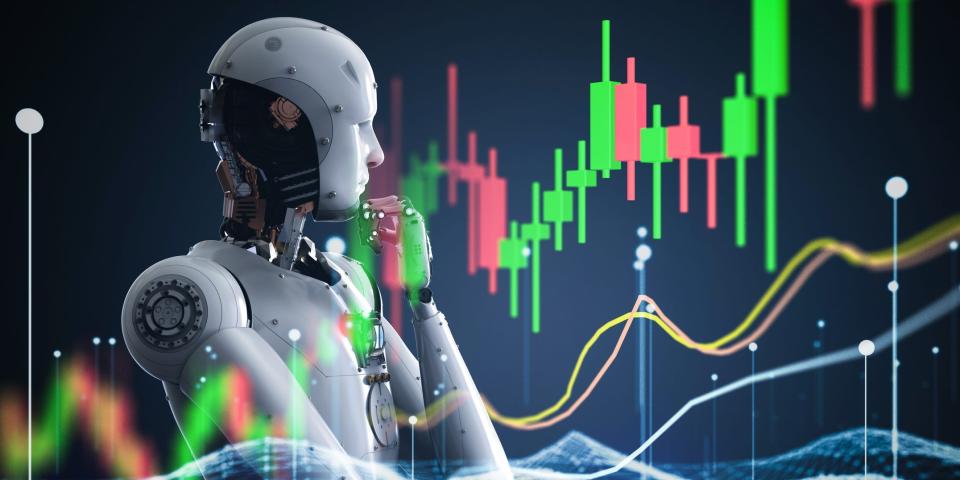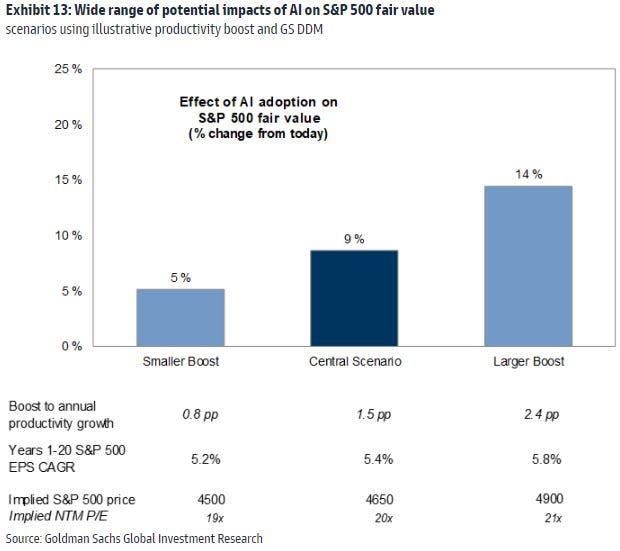The stock market could surge 14% as companies adopt AI to boost productivity and profits, Goldman Sachs says

The stock market could see significant upside as more companies adopt artificial intelligence, according to Goldman Sachs.
The proliferate of AI technologies should help productivity and profits rise, the bank said.
"We estimate the benefit to S&P 500 fair value could be as small at +5% and as large as +14%," Goldman said.
Artificial intelligence has the potential to drive the stock market considerably higher as more companies adopt the technology and see its benefits, according to Goldman Sachs.
The bank said as companies adopt AI technology, both productivity and corporate profits should rise enough to drive the stock market up as little as 5% from current levels or as much as 14%, which would send the S&P 500 to record highs at 4,884. The potential stock market upside depends on profitability gains sparked by AI.
The first example of AI pushing the stock market higher played out with Nvidia on May 29, when the company's stock soared more than 30% after it said demand for its AI chips would drive a surge in its revenue and profits.
"The AI-inspired demand for Nvidia's advanced chips is accelerating so rapidly that the consensus sales forecast published earlier this year is now totally obsolete," Goldman Sachs' Ryan Hammond said.
If more companies can harness the power and potential efficiency gains from AI, then more and more companies could see profit boosts that ultimately send their stock prices higher.
"Our economists estimate that following widespread adoption generative AI could raise annual US labor productivity growth by roughly 1.5 percentage points over a 10-year period," Hammond said, adding that two factors would increase the output of the US economy.
First, employees who are partially exposed to AI and automation should be able to direct their newly freed-up capacity towards other productive activities.
Second, workers who are displaced by AI and automation will eventually become reemployed, boosting total output in new jobs that emerge following AI adoption.
"Increased economy-wide output could translate into increased revenues and earnings for S&P 500 companies, even beyond those firms directly involved in the development of AI," Hammond said.
And the upside in AI isn't limited to companies that make chips that enable the technology, like Nvidia. Instead, companies across different sectors could benefit from AI.
"Every company could theoretically utilize the generative algorithms to improve productivity and profitability. The relatively stable share of revenues allocated to selling, general, and administrative expenses in recent decades, in contrast with large declines in other input costs, highlights the potential gain to profitability from AI," he said.
But there are also risks to Goldman's forecast that could limit potential upside. Aside from it being incredibly difficult to predict the future productivity gains sparked by AI, the government could also limit them.
"One potential policy response could include an increased corporate minimum tax rate, as was recently introduced in the Inflation Reduction Act. The S&P 500 effective tax rate would need to rise from 20% today to roughly 28% in 20 years to offset the potential earnings boost from AI adoption, all else equal," Hammond explained.
He also highlighted that the dot-com bubble serves as a warning to investors to not get expectations too high about the future potential of AI, as they may ultimately be disappointed.
"During the late 1990s, while many of the largest [technology, media, and telecom] stocks continued to grow sales, their inability to meet optimistic investor expectations led to a collapse in valuations," Hammond warned.

Read the original article on Business Insider
